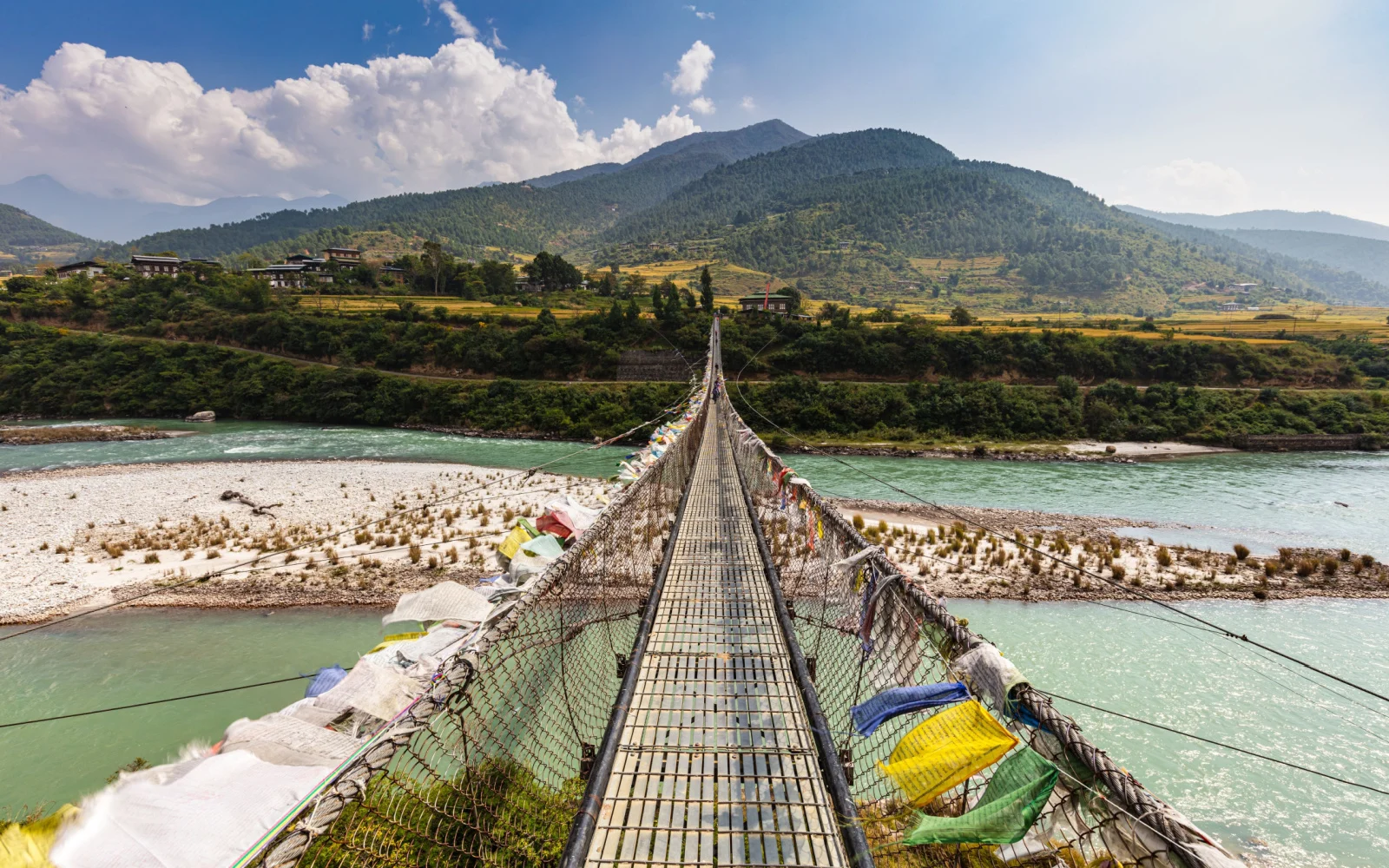What's the best time to visit Bhutan?
The best time to visit Bhutan is during fall and early winter (September to December) for clear skies, pleasant weather, and vibrant festivals. This period offers ideal conditions for exploring Bhutan’s stunning landscapes and cultural landmarks like Tiger’s Nest Monastery.
The mysterious Himalayan country of Bhutan only opened up to tourists a few years ago and still limits how many people can visit. Those who do visit are rewarded with spectacular vistas few other foreigners have seen before.
Some of the main draws of visiting Bhutan are the spectacular mountain landscapes, such as the valleys of the Phunaka region. The country is full of stunning monasteries and dzongs (former fortresses) nestled in craggy mountains, such as the famous Tiger’s Nest Monastery.
Be sure to take time to enjoy the local culture, which you can experience in the archery stadium of the capital, Thimphu, and various village festivals, such as the Royal Highlander Festival.
Chances are that you’ll only be able to visit Bhutan once in your lifetime, so you want to make the most of your visit there.
That’s why it’s crucial to pick the right time to visit so you experience everything the country has to offer. Here is a quick guide that can help you figure out the best time for a tour.
Overall Best Time to Visit Bhutan
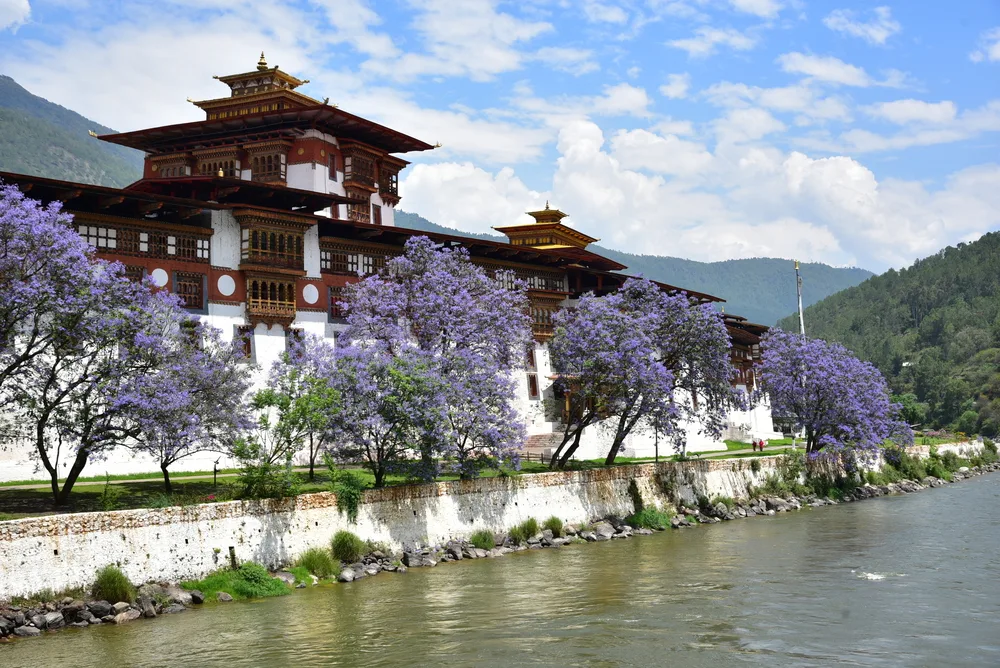
Memoryfor/Shutterstock
The best time to visit Bhutan is during the fall and early winter (September–December), when there are the most festivals and events happening, and the weather is the best for exploring.
Since most of the activities tour companies organize for people visiting Bhutan are outdoors, the weather is an important consideration for planning your trip.
The best time to visit Bhutan for warm yet dry weather conditions is the fall and the very beginning of winter. The climate conditions vary drastically throughout the country, as much depends on the elevation.
In the fall, you can usually expect temperatures of about 50-60 degrees Fahrenheit (10-15 degrees Celsius). By October, the rains also stop, and November and December are two of the driest months in the year.
The end of fall and beginning of winter also bring clear skies, perfect for catching views from the Himalayas. The weather will also affect your ability to get around the country.
Many parts of Bhutan are still rural and underdeveloped, and roads can flood during heavy rains in the late spring and summer. According to the Canadian government’s travel advisory for the country, road conditions in the mountains are often dangerous in the winter due to freezing temperatures, frost, and snowfall.
Fall and early winter are the best times to visit to make sure you can see all parts of the country. The weather is warm enough to travel on all the mountain roads — the monsoon rains are over, so the roads should be repaired after any flooding.
During this season, the country’s infrastructure is at its best. Another aspect of Bhutan that is at its best during the fall is the festival season.
The country has kept its traditional culture close, and many people still maintain their traditional ways of life. The festivals are some of the best ways to see the country’s traditions proudly on display.
Some of the fall’s most popular festivals include:
- Thimphu Tshechu, a tribute to the monk who brought Buddhism to Bhutan, featuring masked dancers and traditional folklore (September)
- Royal Highland Festival, celebrating the traditional culture of the highlands (October)
- Jomolhari Mountain Festival, celebrating the preservation of the snow leopards (October)
- Black-Necked Crane Festival, celebrating the migration of these rare birds (November)
Fall is the most popular season for visitors to Bhutan, but it is the most popular for a reason.
Cheapest Time to Visit Bhutan
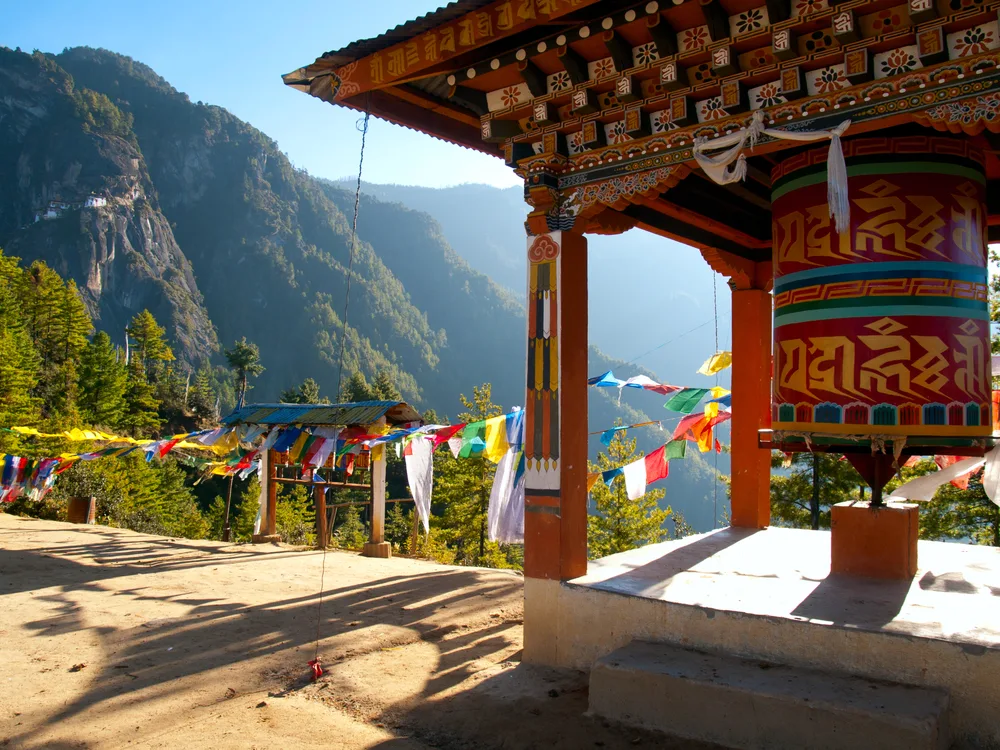
Wouter Tolenaars/Shutterstock
The cheapest time to visit Bhutan is in the summer, but keep in mind that it’s still one of the most expensive destinations in the world, no matter what time you visit.
The summer is Bhutan’s off-season. Not that many people visit due to the heavy monsoon rains. The lower demand means that you can save money on some aspects of your trip.
Flights tend to be slightly less expensive in June, July, and August because fewer people want to travel to Bhutan then. Some hotels also lower their rates during the summer off-season.
You may be able to upgrade your plans and stay in a luxury hotel instead of a simple mountain inn if you book during off-season prices. However, some of the most important expenses you have to budget for on your trip stay the same all year round.
The Bhutanese tourist visa fee is still $100 a night, no matter what time of year you visit. Although you no longer need to book with a tour company to get a visa, you still need an organized tour to visit many more remote parts of the country, and tour companies are now free to set their own prices.
Prices may vary throughout the year depending on the tour company, with some offering discounts for the less popular summer season, so shop around before committing.
No matter when you go, a trip to Bhutan will probably be very expensive, so it doesn’t make too much sense to adjust your travel plans to visit during a less expensive time of the year.
Least Busy Time to Visit Bhutan
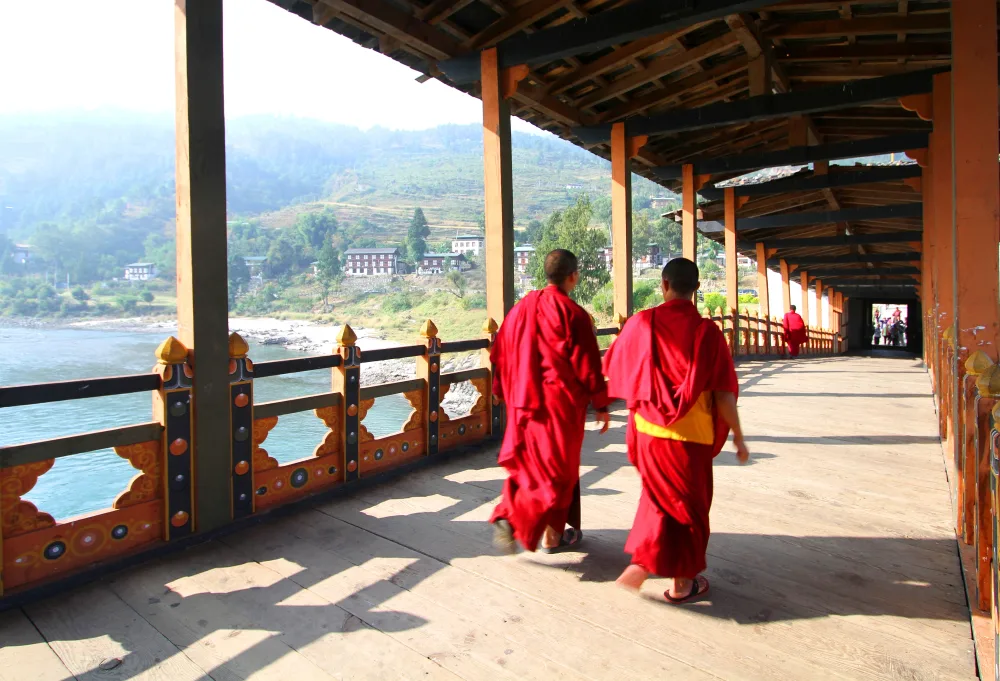
Wantanee Chantasilp/Shutterstock
The least busy time to visit Bhutan is the summer, with the winter also being a great time to come and beat the crowds. Many people avoid traveling to Bhutan during the summer due to the monsoon season.
If you visit then, you’ll probably see few other visitors at popular attractions and maybe snag lower rates for hotels, although you will have to contend with the weather. If you want to avoid the crowds but still have some decent weather, then the winter is the best time to visit.
Although it can get bitterly cold in the mountains, with some roads becoming impassable due to the snow, in the valleys and lowlands, winter is actually quite mild. The cool, crisp air of the winter means that it is one of the best seasons for hiking (as long as you bring appropriate cold-weather gear).
Although higher altitude trails are usually impassable during this season, lower trails are beautiful at this time. The weather is dry, meaning that you have some of the clearest views throughout the year.
Winter is also a good time for birdwatchers, as it’s the season when the rare black-necked crane passes through Bhutan. During the winter, there are fewer festivals, especially in February.
However, you can catch some festivals towards the beginning of the season, such as the Punakha Drubchen, a religious festival in the Punakha Valley.
Worst Time to Visit Bhutan
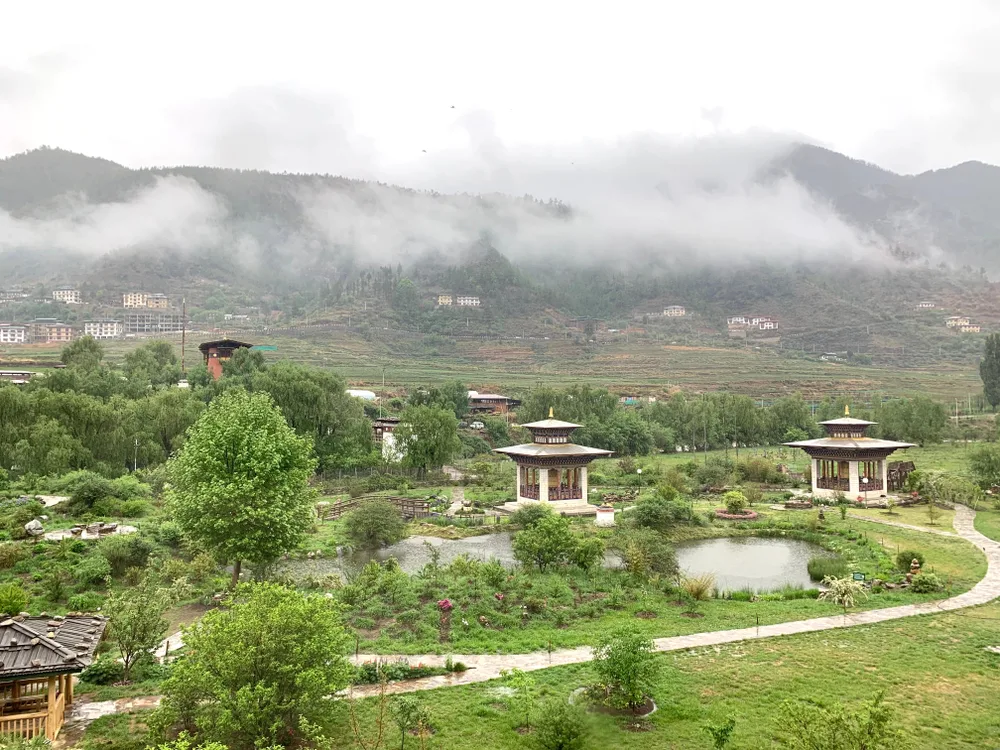
Interior_Travel/Shutterstock
The worst time to visit Bhutan is during the summer, when monsoon rains render much of the country impassable. Although summer is the most affordable time to visit, it isn’t worth it due to the bad weather.
Summer is the monsoon season in Bhutan, and it brings heavy rains. These rains often cause flooding and devastating landslides, particularly in remote parts of the country.
If you were hoping to go on trekking expeditions, summer is the worst time to visit because it is largely impassable. July is the rainiest month in Bhutan, but the rest of the summer can be a doable time to visit.
It usually rains at night, so during the day, you can enjoy weather that is humid and misty but not rainy. In the morning, you can usually go on shorter hikes without experiencing rain and see the countryside at its greenest.
Bhutan by Month: Climate & Activities
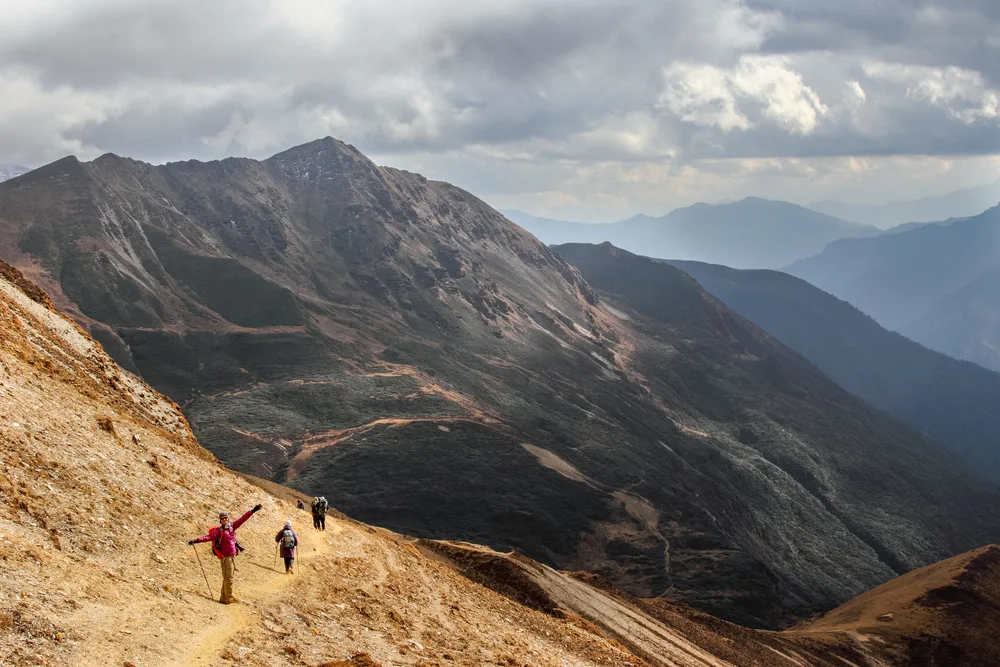
PARO, BHUTAN – circa October 2012: hikers in the mountains of Bhutan/Katiekk/Shutterstock
Still unsure about the best time to visit Bhutan? Take a look at our summary of the weather and climate by month below:
January
January in Bhutan, with chilly temperatures often ranging from 28 to 55°F (-2 to 13°C), is a time of tranquility. This month is ideal for experiencing the serene monastic life, enjoying clear mountain views, and visiting the majestic Paro Dzong.
February
February continues the cool winter charm, perfect for attending the Punakha Drubchen, a traditional festival that re-enacts 17th-century battles, exploring the winter landscapes, and visiting the National Memorial Chorten in Thimphu.
March
As spring approaches, March, with temperatures from 38 to 64°F (3 to 18°C), is great for witnessing the Paro Tshechu, one of Bhutan’s most famous festivals, featuring colorful masked dances and cultural displays, and enjoying the blooming rhododendrons in the valleys.
April
April’s mild weather, temperatures between 44 to 68°F (7 to 20°C), invites you to trek through the stunning landscapes of the Jigme Dorji National Park, visit the iconic Tiger’s Nest Monastery, and explore the artisanal crafts in Thimphu’s markets.
May
May brings warmer days, from 53 to 73°F (12 to 23°C), perfect for bird watching, as many migratory species visit Bhutan, exploring the Haa Valley, and participating in the Ura Yakchoe festival in Bumthang.
June
June, with temperatures between 60 to 75°F (16 to 24°C), ushers in the monsoon season. It’s an ideal time for a cultural tour of the many dzongs (fortresses), visiting the serene Phobjikha Valley, and experiencing Bhutan’s rich Buddhist heritage.
July
July’s mild temperatures, ranging from 62 to 77°F (17 to 25°C), invite you to explore Bhutan’s museums, like the Folk Heritage Museum in Thimphu, and attend local summer festivals in rural villages, offering insights into Bhutanese culture and traditions.
August
In August, with temperatures of 62 to 77°F (17 to 25°C), enjoy the lush green landscapes, visit the traditional farmhouses for an authentic Bhutanese experience, and explore the capital city, Thimphu, for its mix of traditional and modern life.
September
Welcoming fall, September, with temperatures from 57 to 74°F (14 to 23°C), is perfect for attending the Thimphu Tshechu, one of the biggest festivals in Bhutan, trekking in cooler conditions, and enjoying the harvest season in the valleys.
October
October’s cooler days, from 48 to 68°F (9 to 20°C), are ideal for the Jomolhari Mountain Festival, celebrating the culture of communities living near Bhutan’s most sacred peak, and trekking to the Bumdra Monastery for spectacular views.
November
November, as the air turns crisp, temperatures from 40 to 63°F (4 to 17°C), is a time for the Black-Necked Crane Festival in the Phobjikha Valley, exploring Bhutan’s rich textile traditions, and enjoying the serene atmosphere before the onset of winter.
December
December brings cooler weather, from 33 to 58°F (1 to 14°C), along with clear skies ideal for photography. Enjoy the Dochula Druk Wangyel Festival, featuring traditional dance and music, and visit the Punakha Dzong, a stunning example of Bhutanese architecture.
Frequently Asked Questions
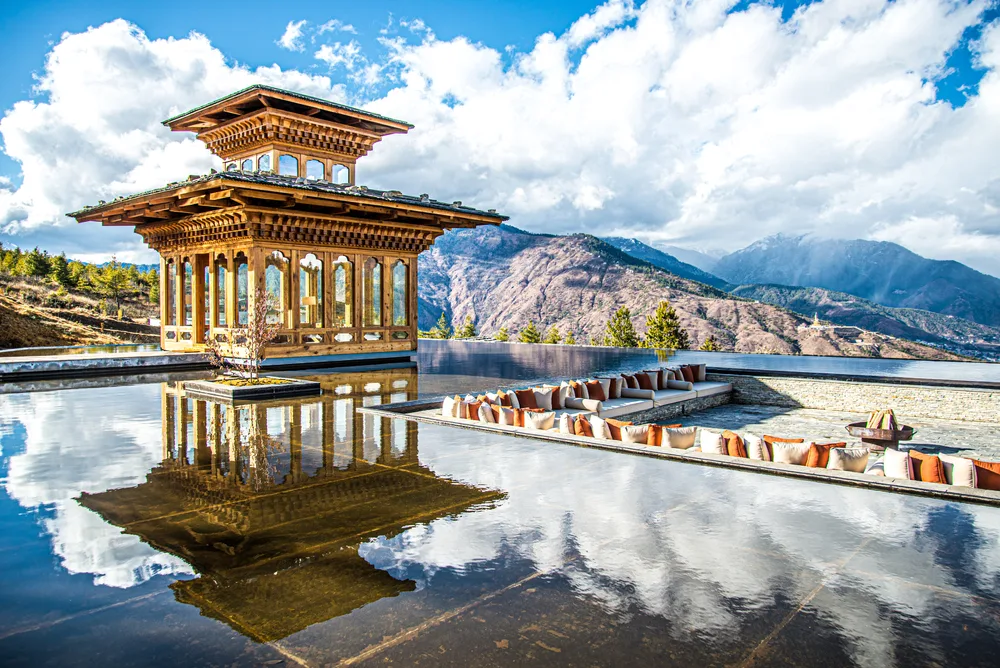
tonyzhao120/Shutterstock
Here are some common questions people ask when picking the best time to visit Bhutan:
What is the best month to visit Bhutan?
December is the best month to visit Bhutan as the weather is crisp but not too cold, and the mountain roads are still passable.
How many days are enough for Bhutan?
Ten days are the minimum for a trip to Bhutan. You want to see the country’s diverse landscapes and give yourself time to adjust to the altitude.
Is traveling to Bhutan expensive?
Yes, traveling to Bhutan is very expensive. You have to pay for a mandatory visa fee on top of tour bookings and accommodations.
Which is off-season in Bhutan?
The summer, between June and August, is the off-season. The off-season is the same as the monsoon season.
Which is the least expensive season to visit Bhutan?
Accommodations and flights are slightly less expensive in the summer. However, it is still expensive to visit no matter what time of year you go.
So, What’s the Best Time to Visit Bhutan?
Bhutan is beautiful any time of year, but it is especially gorgeous during fall and early winter when the weather is crisp and dry and the skies are clearest for spectacular views. Fall is also the high point of the festival season.
So, with so much to see and do and plenty of amazing times to visit, what are you waiting for — book your trip today and experience for yourself all that Bhutan has to offer. Happy travels!



